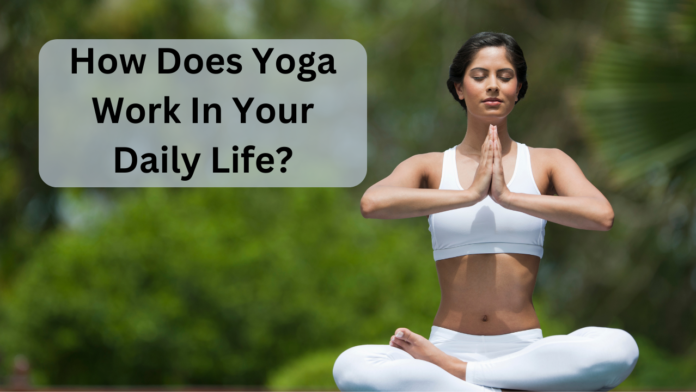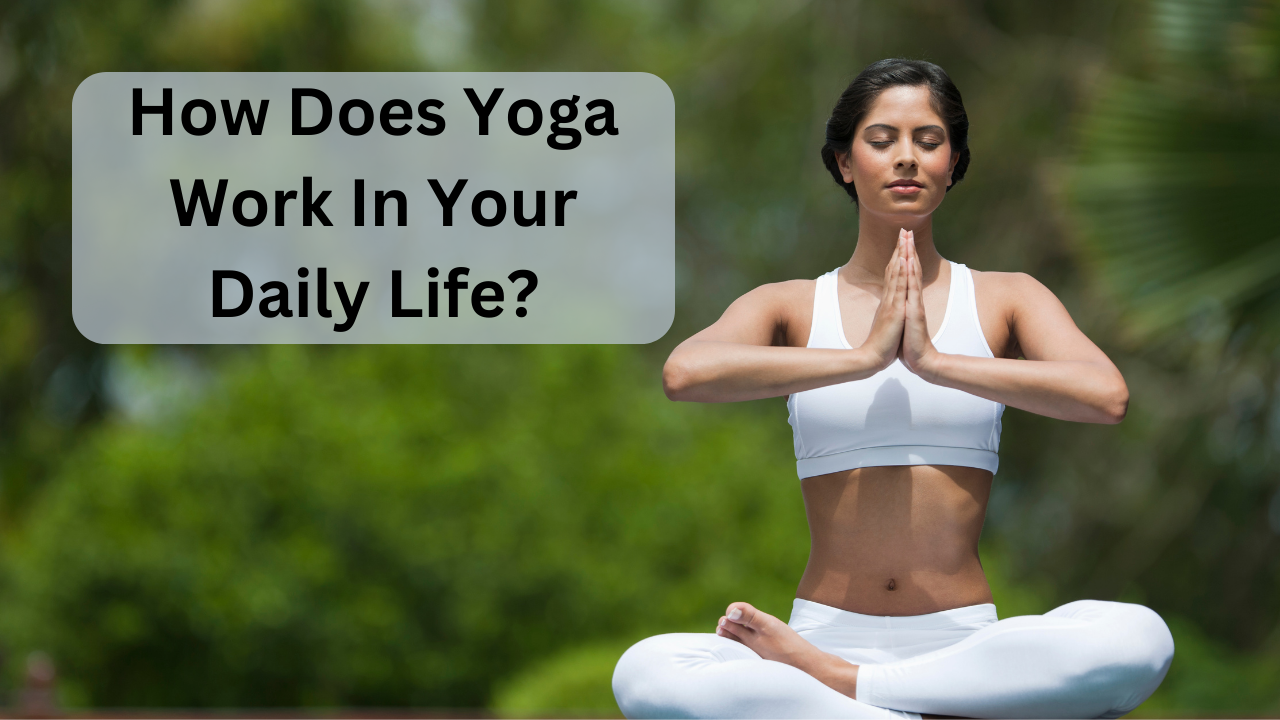Yoga brings positive changes to your daily life. It’s all about feeling good inside and out. Let’s explore what yoga is, how it works in your daily life, its impact on your body, the different types of yoga, discovering the different types, unraveling the incredible benefits it brings, and why it’s basically the chance of feeling good.
What is Yoga?
Yoga is more than just stretching and bending; it’s a way to connect your mind and body. It is just like giving your mind and body a chance to chat and find harmony. Yoga originated in ancient India and has been helping people stay healthy for centuries.
How Does Yoga Affect Your Body?
Yoga is very helpful and important for your body. When you practice yoga regularly, it helps you become more flexible, like a bendy straw. It also strengthens your muscles, making you feel better. But it’s not just about the physical stuff; yoga also helps calm your mind and make your mind peaceful. Deep breaths and relaxation techniques in yoga can reduce stress and boost your mood, making you feel happier overall.
Types of Yoga
Yoga comes in various forms, each catering to different preferences and goals. Whether you seek relaxation, strength, or flexibility, there’s a type of yoga waiting to align with your preferences and contribute to your well-being. Each type has its unique charm, and you can pick the type that feels just right for you.
Hatha Yoga: Hatha Yoga is a gentle yet powerful practice that focuses on the fundamental connection between breath and movement. With an emphasis on foundational poses, it provides a solid introduction for beginners, promoting physical strength, flexibility, and mental clarity. Hatha classes often include a combination of static poses and mindful breathing exercises, creating a holistic experience that nurtures both the body and mind.
Vinyasa Yoga: Vinyasa Yoga is a dynamic and rhythmic practice that seamlessly synchronizes breath with movement. Often referred to as a “flow,” Vinyasa classes involve smoothly transitioning from one pose to another, creating a dance-like sequence. This style emphasizes flexibility, strength, and cardiovascular fitness. With its diverse and creative sequences, Vinyasa Yoga offers a lively and invigorating experience that helps connect the mind and body through the joyous flow of breath and movement.
Bikram Yoga: Bikram Yoga, often known as “hot yoga,” takes the practice to a heated level, with sessions conducted in a room intentionally warmed to around 105°F (40.6°C). This intense heat aims to enhance flexibility, increase circulation, and promote detoxification through profuse sweating. The sequence consists of 26 poses and two breathing exercises, providing a challenging but revitalizing experience. Bikram Yoga enthusiasts appreciate the heat for its potential to deepen stretches and foster a sense of cleansing and rejuvenation.
Ashtanga Yoga: Ashtanga Yoga is a disciplined and structured form of yoga that follows a specific sequence of postures, promoting strength, flexibility, and breath control. It’s like a dynamic dance of continuous movement, with each pose flowing seamlessly into the next. The practice consists of primary, intermediate, and advanced series, each building on the previous one, providing a systematic progression for practitioners. Ashtanga’s rigorous nature cultivates physical endurance and mental focus, making it a favorite among those seeking a challenging and transformative yoga experience.
Yin Yoga: Yin Yoga is a slow-paced and meditative practice that targets deep connective tissues through long-held poses, typically ranging from 3 to 5 minutes. This approach allows for a gentle yet profound stretch, enhancing flexibility and joint mobility. Often described as a “quiet practice,” Yin Yoga focuses on calming the mind and promoting relaxation, making it an excellent choice for stress relief and restoring balance. The emphasis on stillness and mindful breathing fosters a deep sense of introspection, offering a peaceful contrast to more dynamic yoga styles.
Benefits of Yoga
The benefits of yoga can vary from person to person, and consistency is key to experiencing positive changes. Whether you’re a seasoned yogi or just starting, the holistic nature of yoga makes it a versatile and accessible practice for individuals of all ages and fitness levels.
Enhanced Flexibility: Yoga involves a series of poses and stretches that gradually improve your flexibility. Over time, you’ll notice increased suppleness in your muscles and joints, making everyday movements more comfortable.
Better Posture: Yoga emphasizes alignment and body awareness, helping you develop a more conscious and aligned posture. This can alleviate discomfort caused by poor posture and contribute to long-term spinal health.
Stress Reduction: Yoga incorporates mindful breathing and meditation, promoting relaxation and reducing stress levels. The focus on the present moment helps calm the mind, making it an effective tool for managing stress and anxiety.
Increased Energy Levels: Yoga encourages the flow of energy throughout the body. Regular practice can leave you feeling more energized and rejuvenated, countering feelings of fatigue.
Improved Breathing: Yoga places a significant emphasis on breath control or pranayama. Learning to breathe deeply and consciously can enhance lung capacity, increase oxygen intake, and improve overall respiratory function.
Mind-Body Connection: Yoga is a holistic practice that integrates the mind and body. The mindfulness cultivated during yoga helps develop a stronger connection between your physical and mental well-being.
Enhanced Circulation: The combination of movement and breath control in yoga stimulates blood flow, aiding in better circulation throughout the body. Improved circulation contributes to better heart health and overall vitality.
Pain Relief: Yoga can be beneficial for individuals dealing with chronic pain conditions, such as lower back pain or arthritis. Gentle stretching and strengthening exercises in yoga may alleviate discomfort and improve flexibility.
Boosted Immune System: The reduction of stress through yoga and the promotion of overall well-being can positively impact the immune system. A healthier immune system helps the body defend against illnesses.
Emotional Well-being: Yoga is not just about physical postures; it includes practices like meditation that promote emotional balance. It can be a valuable tool for managing mood, reducing symptoms of depression, and fostering a positive outlook on life.
Conclusion
In conclusion, By practicing yoga regularly, you can unlock the secret to a healthier body and a happier mind. So, when you roll out your yoga mat, remember that you are embarking on a journey – a journey towards balance, peace, and self-discovery. Let yoga be your friendly guide, helping you find a little peace in the middle of all the craziness.Take a deep breath, stretch gently, and let the yoga magic sprinkle goodness into every part of your day. It helps you shake off stress, and brings a sense of peace to your busy day.
Imagine it as your daily dose of sunshine, brightening up your mood and making you feel amazing from the inside out. And if you’re curious about diving even deeper into the world of yoga, consider checking out yoga teacher training – it’s like unlocking the next level of your yoga journey! Embarking on a yoga teacher training in Pune provides an avenue to deepen your practice, refine your teaching skills, and inspire others on their path to well-being. It’s not just a certification; it’s an empowering step toward becoming a knowledgeable and compassionate guide, sharing the profound benefits of yoga with the world.


